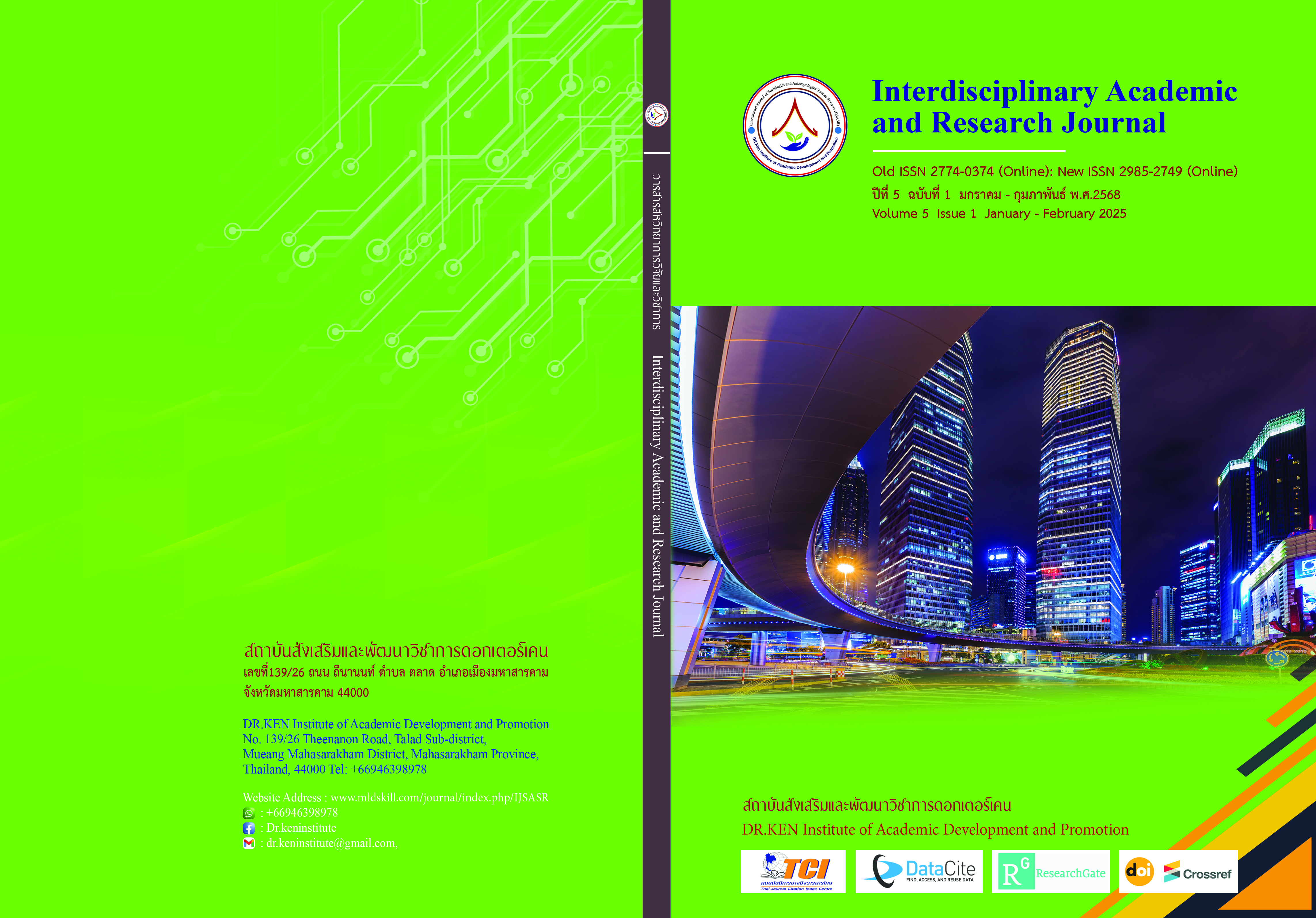Determining Economic Order Quantity for Spare Parts with Variable Purchase Prices: A Case Study of ABC Power Plant
DOI:
https://doi.org/10.60027/iarj.2025.280251Keywords:
Mathematical method, Optimal ordering quantity, Reorder point, SimulationAbstract
Background and Aims: Spare parts inventory control is a critical aspect of the maintenance system in power plants. In this case study, inventory management was largely neglected, leading to excessive inventory and high associated costs. This study aims to develop a quantitative model for determining the optimal order quantities and reorder points for spare parts with variable purchase prices, and to assess the cost-saving potential of this model within the context of the ABC power plant.
Methodology: The study applied quantitative analysis for the case study. Historical data from January until December 2022 of the two selected spare parts were collected. Numerical experiments with 30-year simulation runs were conducted. Related per-year costs including ordering costs, holding costs, interest costs, and product costs, were used to analyze the results.
Results: The study successfully developed a quantitative model for determining the optimal order quantities and reorder points for the two selected spare parts. The cost-saving potential of this new approach was also evaluated. Numerical experimentation revealed that the total costs could be reduced by 35.27% and 40.95% for the primary and final filters, respectively.
Conclusion: The study highlights the significance of effective spare part inventory control in power plant maintenance systems. By applying quantitative analysis and utilizing historical data, the research identified optimal order quantities and reorder points for two critical spare parts. The numerical experiment, using simulation techniques, revealed that implementing the proposed inventory policies could significantly reduce total costs. Specifically, the costs for primary and final filter spare parts were reduced by 35.27% and 40.95%, respectively. These findings underscore the potential benefits of adopting a systematic approach to inventory management in similar settings.
References
การไฟฟ้าฝ่ายผลิตแห่งประเทศไทย. (2563). เจาะลึกภารกิจ “บำรุงรักษาเครื่องกลโรงไฟฟ้า” เพื่อความมั่นคงพลังงานไฟฟ้าไทย. Retrieved July 21, 2024, from: https://www.egat.co.th/home/ 20200929-art01/.
ขวัญชัย หักทะเล. (2557). การจัดการพัสดุคงคลังอะไหล่เพื่อตอบสนองความต้องการของงานซ่อมบำรุงเชิงป้องกันและเชิงเร่งด่วน. วิทยานิพนธ์ปริญญาวิทยาศาสตรมหาบัณฑิต: มหาวิทยาลัยบูรพา.
นิชานันท์ บุญสร้าง. (2566). การหาปริมาณการสั่งซื้อแบบประหยัดของอะไหล่ กรณีราคาซื้อแปรผันของโรงไฟฟ้าแห่งหนึ่ง. การค้นคว้าอิสระปริญญาวิทยาศาสตรมหาบัณฑิต: มหาวิทยาลัยเทคโนโลยีพระจอมเกล้าธนบุรี.
ปริญญา จันทรวินิจ, & ศิริจันทร์ ทองประเสริฐ. (2556). การปรับปรุงระบบการคงคลังอะไหล่สําหรับเครื่องจักรการผลิต. วิศวกรรมสารฉบับวิจัยและพัฒนา, 24(1), 58-66.
ปารเมศ ชุติมา, & สุทัศน์ รัตนเกื้อกังวาน. (2551). การปรับปรุงประสิทธิภาพการจัดการสินค้าสําหรับบริษัทให้บริการซ่อมอุปกรณ์เทคโนโลยีสารสนเทศ. วารสารรามคําแหง ฉบับวิศวกรรมศาสตร์, 2(2), 55-67.
ภิญญาพัชญ์ วัฒนะธนากร. (2560). การศึกษารูปแบบการพยากรณ์เพื่อการบริหารสินค้าคงคลังประเภทเวชสำอางและยา: กรณีศึกษา. การค้นคว้าอิสระปริญญาวิทยาศาสตรมหาบัณฑิต: มหาวิทยาลัยเทคโนโลยีพระจอมเกล้าธนบุรี.
วราภรณ์ หมื่นสุนทร. (2561). การปรับปรุงระบบจัดการอะไหล่คงคลังในโรงงานปั๊มชิ้นงานเหล็ก. วิทยานิพนธ์ปริญญาวิศวกรรมศาสตรมหาบัณฑิต: จุฬาลงกรณ์มหาวิทยาลัย.
ศรันย์พร เส็งพานิช. (2565). การจัดการสินค้าคงคลังประเภทอะไหล่สำรอง กรณีศึกษาของบริษัทผลิตบรรจุภัณฑ์. งานนิพนธ์ปริญญาวิทยาศาสตรมหาบัณฑิต: มหาวิทยาลัยบูรพา.
สมัชชา นุ่มพูล. (2556). การพัฒนาแบบจำลองการจัดการอะไหล่คงคลัง กรณีศึกษา อุตสาหกรรมกระจก. วิทยานิพนธ์ปริญญาวิศวกรรมศาสตรมหาบัณฑิต: มหาวิทยาลัยศิลปากร.
สุพร หลักมั่นคง. (2561). ความสำคัญของโรงงานผลิตกระแสไฟฟ้าขนาดใหญ่ต่อความมั่นคงแห่งชาติ. วารสารรัฏฐาภิรักษ์, 60(2), 84-90.
Alam, M. K., Thakur, O. A., & Islam, F. T. (2024). Inventory Management Systems of Small and Medium Enterprises in Bangladesh. Rajagiri Management Journal, 18(1), 8-19.
Appadoo, S.S., Bector, C.R., & Bhatt, S.K. (2012). Fuzzy EOQ Model using Possibilistic Approach. Journal of Advances in Management Research, 9(1), 139–164.
Atnafu, D., & Balda, A. (2018). The Impact of Inventory Management Practice on Firms’ Competitiveness and Organizational Performance: Empirical Evidence from Micro and Small Enterprises in Ethiopia. Cogent Business and Management, 5(1), 1503219. https://doi.org/10.1080/23311975.2018.1503219
Baron, O., Berman, O., & Perry, D. (2011). Shelf space management when demand depends on the inventory level. Production and Operations Management, 20(5), 714-726.
Browne, S., & Zipkin, P. (1991). Inventory Models with Continuous, Stochastic Demands. The Annals of Applied Probability, 1(3), 419-435.
Choi, T.-M. (Ed.). (2013). Handbook of EOQ Inventory Problems: Stochastic and Deterministic Models and Applications. New York, NY: Springer.
Chopra, S. (2020). Supply Chain Management: Strategy, Planning, and Operation. 7th edition. Hoboken, NJ: Pearson.
Erdem, A. S., Fadilog̃lu, M. M., & Özekici, S. (2006). An EOQ model with Multiple Suppliers and Random Capacity. Naval Research Logistics, 53, 101–114.
Hasbullah, H., Mustarih, M. M., & Wibowo, A. A. (2021). Improving material shortage for small-medium enterprises (SME) in the pest control industry. Journal of Industrial Engineering and Management Research, 2(3), 62-71.
Kharde, B., Patil, G., & Nandurkar, K. (2012). EOQ Model for Planned Shortages by Using Equivalent Holding and Shortage Cost. International Journal of Industrial Engineering Research and Development, 3(1), 43-57.
Law, A. M. (2024). Simulation Modeling and Analysis. (6th ed.). New York, NY: McGraw-Hill.
Mesquita, M. A., & Tomotani, J. V. (2022). Simulation-optimization of Inventory Control of Multiple Products on a Single Machine with Sequence-dependent Setup Times. Computers & Industrial Engineering, 174, 108793, https://doi.org/10.1016/ j.cie.2022.108793.
NECTEC. (2023). ระบบบริหารอะไหล่กังหันก๊าซ (Gas Turbine Spare Parts Management System). Retrieved July 21, 2024, from: https://www.nectec.or.th/innovation/innovation-software/gasturbinesparepart.html
Solari, F., Lysova, N., & Montanari, R. (2024). Perishable Product Inventory Management in the Case of Discount Policies and Price-Sensitive Demand: Discrete Time Simulation and Sensitivity Analysis. Procedia Computer Science, 232, 1233-1241.
Waters, D. (2003). Inventory Control and Management. (2nd ed.). Chichester, England: John Wiley & Sons Ltd.
You, F., & Grossmann, I.E. (2011). Stochastic Inventory Management for Tactical Process Planning Under Uncertainties: MINLP Models and Algorithms. AIChE Journal, 57(5), 1250-1277.
Zhang, S., Huang, K., & Yuan, Y. (2021). Spare Parts Inventory Management: A Literature Review. Sustainability, 13(5), 2460. https://doi.org/10.3390/su13052460.
Zhu, H., Liu, X., & Chen, Y. (2015). Effective Inventory Control Policies with a Minimum Order Quantity and Batch Ordering. International Journal of Production Economics, 168, 21-30.
Downloads
Published
How to Cite
Issue
Section
License
Copyright (c) 2025 Interdisciplinary Academic and Research Journal

This work is licensed under a Creative Commons Attribution-NonCommercial-NoDerivatives 4.0 International License.
Copyright on any article in the Interdisciplinary Academic and Research Journal is retained by the author(s) under the under the Creative Commons Attribution-NonCommercial-NoDerivatives 4.0 International License. Permission to use text, content, images, etc. of publication. Any user to read, download, copy, distribute, print, search, or link to the full texts of articles, crawl them for indexing, pass them as data to software, or use them for any other lawful purpose. But do not use it for commercial use or with the intent to benefit any business.
















.png)


